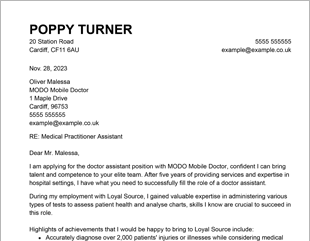How to Write a Letter for Family Emergency Leave
Write to inform your employer you’re taking emergency leave with this family emergency leave letter writing guide and examples.
Write to inform your employer you’re taking emergency leave with this family emergency leave letter writing guide and examples.





OUR USERS HAVE BEEN HIRED BY
Life is unpredictable, and we can’t always know what it’ll throw at us. Sadly, there may be times when there’s a family emergency, and you need to take time off work at short notice. Most employers will understand that you need to be there for your family members at this difficult time. While it’s not a requirement to offer compassionate leave, many companies do so. However, you’ll still have to write a letter letting your employer know what’s happened and that you’ll be taking some time off. This article covers what to include in your emergency holiday request letter and how to format it. We’ve also provided an example of what the letter should look like.
An emergency holiday request letter should be laid out in the letter format style of a standard professional letter, with the date, your address, and your employer’s address at the top, a formal salutation, and clear, defined paragraphs. The letter doesn’t need to be too long, but there are a few key points it should contain. You should include the following information in your family emergency leave letter:
You don’t have to include the full details of the family emergency leave, as it might be a private matter. However, your employer at least needs a rough idea of the reason you need family emergency leave, and you should share as much detail as you feel comfortable with, as this will be your justification for taking a leave of absence. A few sentences talking about who was affected and where you need to be (perhaps you need to travel to be with a relative or stay home to look after someone who is sick) should suffice.
You should specify the period of time you’ll be taking off and your expected return date. As situations can change, it might also be good to offer to keep your employer updated about how things are going and let them know if anything happens that could affect when you can come back to work.
Although you may be in no frame of mind to think about work, it’s good to acknowledge any impact that your absence could have and let your employer know if you’ve set up contingency plans, such as asking other colleagues to take on your work while you’re gone. If you feel your work won’t be too heavily impacted, this is also a good chance to communicate that to your employer.
Provide your employer with your contact information, including the best phone number and email address to reach you whilst you are away. This is particularly important if you’re traveling elsewhere, for example, if you need to go and visit family in another city or country. It might also be helpful to specify when it would be best for your employer to contact you by phone call.
A family emergency leave letter should contain a brief explanation of the emergency you’re facing in the form of a letter that also lets your direct supervisor know when you expect to return. You only need to share this letter with who you are comfortable with sharing, but you can give details on the emergency if you feel it is appropriate.
A family emergency is an emergency where anyone who may depend on you for care (spouse, parent, sibling, child, etc.) has taken ill or been involved in an accident. Again, personal reasons are disclosed between yourself and your HR manager at your discretion, and you can go into as much detail as you are comfortable with.
Usually you will need to inform your employer of your absence. To check what your company requires you to tell them, check your company policies and leave policies. These policies will also help you understand if this will be unpaid leave, as not all employers are required to pay you for emergency leave.
We personalize your experience.
We use cookies in our website to ensure we give you the best experience, get to know our users and deliver better marketing. For this purpose, we may share the information collected with third parties. By clicking “Allow cookies” you give us your consent to use all cookies. If you prefer to manage your cookies click on the “Manage cookies” link below.